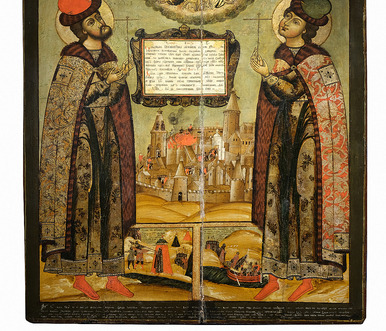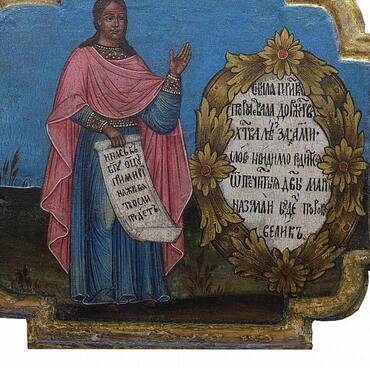Kokoshnik is a festive headdress of a young married woman, in the old days it was the most important part of a woman’s costume. It was worn only with dresses made of expensive purchased silk or brocade. For the first time, the kokoshnik was put on immediately after the church wedding: a headband was removed from the head, a maiden’s braid was unwound, two braids were braided and a kokoshnik was put on. A headscarf was necessarily tied over it — this was done so that the front and side parts remained visible. In the cold season, rich Kargopol women wore hats with sable trimming on the top of the kokoshnik. Such hats were nicknamed “boats” for their extravagant shape.
Not every bride could afford an expensive headdress, so kokoshniks were often borrowed for the wedding. Kokoshniks were usually worn for another year after the wedding and then on major holidays. The festive headdresses were carefully preserved and inherited, they served as an indicator of the prosperity of the family. In peasant families, kokoshniks were considered a kind of reserve fund. So, in the early 20th century, a headdress with pearls cost an average of 50-70 rubles — enough to buy a horse.
The kokoshnik consists of three main parts. The part above the forehead is called the “ochelye”, its sides also cover the ears. The second part is the bottom. The third is the back.
The ochelye of the kokoshnik from the museum’s collection is embroidered with beads and small pieces of mother-of-pearl. The beads are made of glass with the mother-of-pearl coating to imitate pearls. Small pieces of pearl are beads from the inner shell layer of mollusks, flat on one side and slightly convex on the other. There is a rosette in its center — the ornament motif in the form of petals of a blooming flower. Small patterned plants are located on the sides of the rosette.
A pattern in the form of a trident and a flower with five petals is embroidered on the sides — it is made with special metal threads made of real gold. A string of beads — the net sewn to the bottom edge — is quite small, it is arranged in one row and decorated with beads.
Throughout the Kargopol region, kokoshniks were decorated in different ways, depending on the chosen material. The central part of the region — in the town and neighboring territories — had the tradition of using river pearls and seed beads, creating kokoshniks with massive long strings of beads arranged in many rows.
To the north along the Arkhangelsk tract, the Onega and Kena rivers, as well as in places in the area of the Lake Kenozero, the headdresses were decorated with beads. Most likely, the kokoshnik from the museum was created in those places. It entered the funds as part of the collection of the museum’s founder Kapiton Kolpakov.
Not every bride could afford an expensive headdress, so kokoshniks were often borrowed for the wedding. Kokoshniks were usually worn for another year after the wedding and then on major holidays. The festive headdresses were carefully preserved and inherited, they served as an indicator of the prosperity of the family. In peasant families, kokoshniks were considered a kind of reserve fund. So, in the early 20th century, a headdress with pearls cost an average of 50-70 rubles — enough to buy a horse.
The kokoshnik consists of three main parts. The part above the forehead is called the “ochelye”, its sides also cover the ears. The second part is the bottom. The third is the back.
The ochelye of the kokoshnik from the museum’s collection is embroidered with beads and small pieces of mother-of-pearl. The beads are made of glass with the mother-of-pearl coating to imitate pearls. Small pieces of pearl are beads from the inner shell layer of mollusks, flat on one side and slightly convex on the other. There is a rosette in its center — the ornament motif in the form of petals of a blooming flower. Small patterned plants are located on the sides of the rosette.
A pattern in the form of a trident and a flower with five petals is embroidered on the sides — it is made with special metal threads made of real gold. A string of beads — the net sewn to the bottom edge — is quite small, it is arranged in one row and decorated with beads.
Throughout the Kargopol region, kokoshniks were decorated in different ways, depending on the chosen material. The central part of the region — in the town and neighboring territories — had the tradition of using river pearls and seed beads, creating kokoshniks with massive long strings of beads arranged in many rows.
To the north along the Arkhangelsk tract, the Onega and Kena rivers, as well as in places in the area of the Lake Kenozero, the headdresses were decorated with beads. Most likely, the kokoshnik from the museum was created in those places. It entered the funds as part of the collection of the museum’s founder Kapiton Kolpakov.



